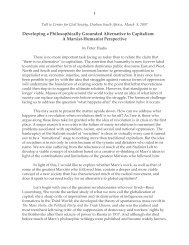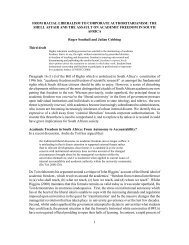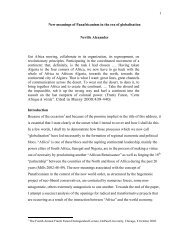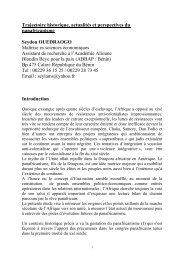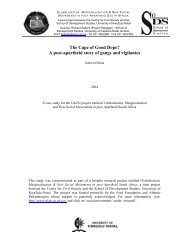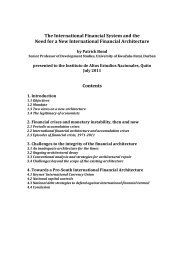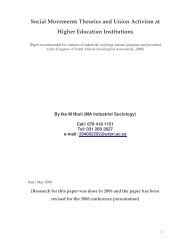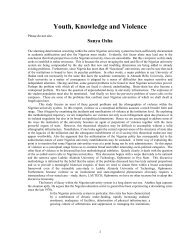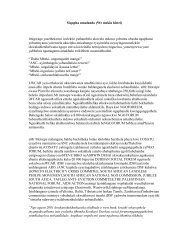April 2011 - Centre for Civil Society - University of KwaZulu-Natal
April 2011 - Centre for Civil Society - University of KwaZulu-Natal
April 2011 - Centre for Civil Society - University of KwaZulu-Natal
Create successful ePaper yourself
Turn your PDF publications into a flip-book with our unique Google optimized e-Paper software.
‘How can a green revolution be achieved in Africa?’ After more than a year<br />
<strong>of</strong> study, the expert panel, commissioned by then UN Secretary General<br />
K<strong>of</strong>i Annan, replied as follows: ‘no single technological bullet is available<br />
<strong>for</strong> radically improving African agriculture.’ African agriculture will require<br />
numerous ‘rainbow evolutions’ across the diverse African farming systems,<br />
‘rather than a single Green Revolution.’[1]<br />
By 2007, however, Annan agreed to be executive director <strong>of</strong> the Alliance<br />
<strong>for</strong> a Green Revolution <strong>for</strong> Africa (AGRA), funded by the Bill & Melinda<br />
Gates and Rockefeller Foundations. AGRA proposes exactly the kind <strong>of</strong><br />
agriculture the panel <strong>of</strong> agricultural experts (from South Africa, Nigeria,<br />
Uganda, Morocco, Brazil, Mexico, Japan, China and more) rejected:<br />
Monoculture <strong>of</strong> one or two crops with the goal <strong>of</strong> increasing yields through<br />
the high use <strong>of</strong> fossil fuels, chemicals (fertilisers, pesticides) and<br />
biotechnology (patented genetically modified seeds). AGRA finances<br />
agricultural research and lobbies across the globe (e.g., January in Davos)<br />
to extend outdated 20th century industrial agriculture to the African<br />
continent.<br />
Current crises in global agriculture affect the African continent the most,<br />
from agr<strong>of</strong>uels replacing food to market failures and privatisation <strong>of</strong> living<br />
organisms. Because <strong>of</strong> their place in the international division <strong>of</strong> labour<br />
(including South Africa) as primary commodity exporters, with little or no<br />
value-added processing, African economies remain vulnerable to the<br />
vagaries <strong>of</strong> both weather and markets.<br />
Given these dire situations, how could Africa possibly <strong>of</strong>fer alternatives to<br />
the dominant industrial agriculture <strong>of</strong> ‘green revolutions’? After briefly<br />
summarising the various threats <strong>of</strong> the global agricultural crises to African<br />
food security, this article analyses African alternatives, focusing on their<br />
approach to farmers' rights and an initiative to award and disseminate<br />
African innovations.<br />
GLOBAL AGRICULTURAL CRISES – THE VIEW FROM AFRICA<br />
AGROFUELS<br />
As the demand <strong>for</strong> agr<strong>of</strong>uels seems to be insatiable, global corporations<br />
are noticing Africa <strong>for</strong> its extensive land masses, while not seeing the<br />
hungry. Calling Africa the ‘green OPEC’, they assert that 15 countries in<br />
Africa have a total combined land area greater than all <strong>of</strong> India ‘available’<br />
<strong>for</strong> agr<strong>of</strong>uel production, not bothering to explain what ‘available land’<br />
means in the context <strong>of</strong> a food deficit continent.[2]<br />
Europe and the USA have set ‘green’ targets <strong>for</strong> agr<strong>of</strong>uel consumption that<br />
they cannot fulfill using their own land. The agr<strong>of</strong>uel ‘craze’ there<strong>for</strong>e<br />
very much depends on global corporations’ taking command <strong>of</strong> land in<br />
South countries in order to grow agr<strong>of</strong>uel crops.<br />
To further the problem, the amount <strong>of</strong> plant material needed is massive.<br />
Lester Brown <strong>of</strong>fers the comparison that the amount <strong>of</strong> grain required to<br />
fill the 90-litre petrol tank <strong>of</strong> a 4 × 4 vehicle once with maize ethanol<br />
could feed one person <strong>for</strong> a year. The grain it takes to fill the tank every<br />
two weeks over a year would feed 26 people.[3]<br />
The extent <strong>of</strong> African land coveted by investors, there<strong>for</strong>e, expands to<br />
tens millions <strong>of</strong> hectares, involving 20 countries.[4] No matter how the<br />
land is allocated – from leasing to contract farming – its use will be<br />
overwhelmingly <strong>for</strong> <strong>for</strong>eign consumption. Such major tracts <strong>of</strong> land<br />
designated to meet <strong>for</strong>eigners' energy or food needs signals, once again,<br />
the expatriation <strong>of</strong> African lands.



